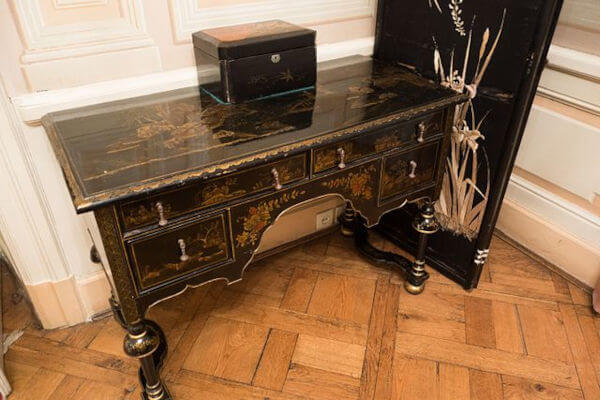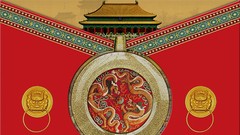
Chinese lacquerware is a method where artisans use lacquer to coat the outer surface of furniture, sculptures, accessories, and other things that are typically made of wood or metal.
‘Lacquerware’, refers to objects that have been coated or covered with lacquer.
‘Lacquer’, on the other hand, refers to a unique type of natural resin that is quite common throughout China, which is created from the treated, dried, and dyed sap of Toxicodendron vernicifluum and other similar trees. The sap produces a rather unique, buttery smell when harvested. The sap is also a quite strong allergen, and if you’re not careful when touching it, can cause the body part touching it to become swollen as an allergic reaction.
When processed as a resin, however, lacquer has really good anti-moisture, heat resistance, and anti-corrosion qualities. Meaning, furniture, and tools coated with lacquer will become stronger and more durable, while also giving a unique luster to the coated tools.
Producing high-end Chinese lacquerware can take a very long time. This is because lacquer counting should be done slowly, layer by layer. Each layer can take quite a long time before it dries up, and there’s no other way besides waiting for it. Different lacquerware artisan may want to add different layers of lacquer coating, and once this target has been achieved, the artisan will then polish and finalize the object.
High-end Chinese lacquerware can look very polished with its translucent and elegant luster.
Origins and History of Chinese Lacquerware
As a tradition passed down from generation to generation, Chinese lacquerware has a very long history throughout the history of China:
Pre-Han Period (Before 202 BC)
- The oldest finding of Chinese lacquerware is believed to have originated from the end of the Neolithic era, found on the Hemudu Site in the lower Yangtze region.
- Entering the Bronze Age, lacquerware becomes more common. Many artifacts and ornaments from this period have a lacquer coating on them.
- During the Warring States period (476-221 BC), economic and production powers have increased, and many tools used on rituals and ceremonies have lacquer coating on them. It was common for people in this era to put various types of lacquerware near tombs (bowls, glasses, etc.). This indirectly showed us how lacquerware has become commonplace during this period.
Han Dynasty Period (202 BC-220 AD)
During the Han dynasty period, Chinese lacquerware experienced various advancements and developments. More lacquering techniques were invented and lacquering to add durability and luster to various objects has become a common tradition performed by many people during this period.
As discussed above, lacquering can take a very long time, and this is why the lacquering artisans flourished during this era due to the high demand for lacquerware.
An important lacquerware finding from this period is a coffin from an aristocratic family. The wife of this family was buried with a lacquerware coffin that is very luxurious and beautiful. Due to the thickness of the lacquer coating applied, the coffin is still well preserved, showing its great details even today.
See some beautiful Chinese Lacquerware Products – Opens in new tab.

Tang Dynasty Period (618-907 AD)
During this period, various breakthroughs in lacquering techniques have occurred, elevating the Chinese lacquerware to enter another level.
Artisans who wanted to sell their lacquerware with higher values have added silver and gold to the object, carved in various designs (animals, flowers, birds, etc.). This metal sculpture will then be added to an object that has already been coated with lacquer, and then the artisan will add another lacquer coating to ‘fuse’ the object with the sculpture.
Song Dynasty Period (960-1279 AD)
During the Song dynasty, adding silver and gold to lacquerware was becoming even more popular, increasing the demands for lacquerware artisans that are also capable of crafting silver and gold.
This period is widely accepted as the period that invented various new techniques in Chinese lacquering.
For example, qianjin is a very popular technique during this period where artisans performed gold engraving on the object before it is coated by lacquer. Diaotian is another common and important technique where artisans are mixing the lacquer with other substances to produce additional colors. Diaoqi is a technique of adding carving to objects before they are being lacquered.
Due to its increase in popularity, as well as technical development, many people from other countries fell in love with lacquering, and many of them have started learning lacquerware in China. As they went back to their countries, many of them developed their own lacquering style, like the Kamakura Bori in Japan.
Yuan Dynasty (1271-1368 AD)
The complexity and overall value of Chinese lacquering entered yet another level during the Yuan dynasty period. The artisans in this era have learned the various techniques used in the previous dynasties and used them to create more complex designs and carvings. Many artisans of this era also mixed gold or silver powder into the lacquer, which produces a unique luster to the coated objects, making them look more elegant and expensive.
Various techniques like incising, engraving, and filling, among others, are also further developed during this period, which can be seen in various findings from this period. Many lacquerware objects that originated from this era have shown very detailed carvings with high complexity in various shapes: floral patterns, dragons, serpents, and so on. Also, most of these objects feature very thick lacquer coatings, making them very valuable and expensive.
See some beautiful Chinese Lacquerware Products – Opens in new tab.

Ming Dynasty (1368-1644 AD)
During the Ming dynasty period, lacquer carving became a very popular trend, and there are many high-end Ming-period lacquerwares that are still very valuable today, sought after by many art collectors all around the world.
Also, many factories and production centers for Chinese lacquerware were built throughout this period. Very high standards have been applied to the lacquerwares produced during the reign of Emperor Ming Yongle, and many experts think that the very best lacquerwares were produced during this era.
There are many lacquerware findings from this era in the form of tools and appliances like bowls, cups, trays, and boxes, many of them have red as their basic color. This is because the lacquer used during the Ming dynasty period has a mixture composition that produces the reddish color.
However, there are also decorative objects like carvings shaped like dragons, phoenixes, and various other mythical animals with gold coatings. This is made possible by mixing gold powders into the lacquer used to coat these objects.
Qing Dynasty (1644-1912 AD)
Not too many developments happened during this period. However, the Qing dynasty is responsible for preserving the complex techniques and traditions accumulated throughout the previous dynasties, allowing the Chinese lacquerware tradition to survive until today.
Even today, we can still find various crafts and ornaments coated with Chinese lacquer all around China, as well as in many countries all around the world.
Nearing the end of the Qing dynasty, many Europeans visited China, and many of them became interested in lacquerwares. This is why many Chinese lacquerwares were exported to Europe during this period.

Different Chinese Lacquerware Techniques
Due to its very long history, many lacquerware techniques we can find today are actually combinations and modifications of older techniques and methods. However, here are some of the prominent techniques that are still popular today:
Beijing Carve Lacquer
One of the oldest lacquer techniques, the Beijing carve lacquer method achieved its glory throughout the Ming and Qing period. Even today, it is still the most popular technique used by lacquer artisans.
The main characteristic of this technique is the huge number of coating layers involved. At the very least, 100 coatings must be given before the lacquered object is polished.
Another unique technique here is the golden paint inlay: by mixing gold powders into lacquer, the coated objects become more radiant and elegant, even if they are originally relatively simple objects.
The main downside of this technique is the very long development period, which can take at least 6-8 months. Due to its complexity, it’s also difficult to teach this technique to future generations.
See some beautiful Chinese Lacquerware Products – Opens in new tab.
Pingyao Glassing Lacquer
Another very old technique that can be traced back to the Tang dynasty period. Also, this is a very complex and difficult technique that doesn’t use any chemicals or synthetic substances. The complexity of the technique and lacquer purity, however, allows the finished product to have its unique luster and very smooth, glass-like surface.
The secret of this technique is the special lacquer sap that can only be found in Pingyao and its surrounding areas. This unique sap is then mixed with other secret ingredients (which can vary between different artisans). However, most of them use pig blood and brick dust to produce a unique color.
Fuzhou Bodiless Lacquer
A rather unique technique that was developed during the early part of the Qing dynasty. Very complex with a unique aesthetic value on its products when compared to the other techniques.
In this technique, clay, wooden bodies, and plaster, on which silk cloth or grass, and raw lacquer are applied layer by layer. Then, the original wooden body is removed or smashed (hence the name ‘bodiless’), leaving only the lacquered cloth. The lacquered cloth will then be polished, painted, and coated with additional lacquer.
Primarily produced in Fuzhou, and while this technique doesn’t produce the brilliant luster of other techniques, the bodiless lacquer technique produces more sharper and brighter colors, which give this technique its unique characteristic.
Related reading: Innovation Through the Ages: Unraveling the Timeline of Chinese Inventions – Opens in new tab
Online Courses about Chinese Culture from Udemy (Aff.link)

Stay in Touch
 Join our newsletter by using the forms on this website or click here!
Join our newsletter by using the forms on this website or click here! Follow us on Google News
Follow us on Google News Follow us on Facebook
Follow us on Facebook
Featured image by THOR from Wikimedia Commons (CC BY 2.0)




